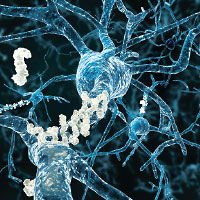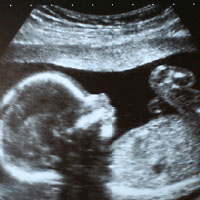Journal Digest: Amyloid Clearance, Fetal Anatomy and Autism, and More
Amyloid Clearance May Be Tied to Circadian Clock

The brain’s ability to remove Alzheimer’s-associated amyloid-beta protein may be regulated by the circadian cycle, according to a study published in PLOS Genetics.
“These data highlight that circadian regulation in immune cells may play a role in the intricate relationship between the circadian clock and [Alzheimer’s disease],” wrote researchers from the Rensselaer Polytechnic Institute in New York and colleagues.
Though clumps of the amyloid-beta 42 (Aβ42) protein periodically form in the brain, immune cells known as macrophages can ingest and break the proteins down via a process known as phagocytosis.
The researchers studied mouse-derived macrophages and fluorescent Aβ42 molecules over the course of a day. They found that the rate of Aβ42 phagocytosis peaked around hour 20 and dipped around hour 8 (with hours 0-12 representing day and 12-24 representing night). The phagocytosis of a related but nontoxic variant of amyloid-beta called Aβ40 did not appear to change over the course of the day.
The investigators also found that the key regulators of the phagocytosis cycle were molecules on the macrophage surface known as proteoglycans (proteins capped with long carbohydrate chains). In particular, the production of proteoglycans that are capped with heparin sulfate was opposite that of Aβ42 phagocytosis—with production greatest at hour 8 and lowest at hour 20. When the investigators exposed macrophages to a chemical that dissolves heparin sulfate, phagocytosis no longer fluctuated, but rather remained at peak activity all day.
Clark GT, Yu Y, Urban CA, et al. Circadian Control of Heparan Sulfate Levels Times Phagocytosis of Amyloid Beta Aggregates. PLOS Genet. 2022; 18(2): e1009994.
Fetal Anatomy Ultrasound Offers Clues About ASD Risk

Prenatal ultrasounds may offer clues about children most likely to go on to develop autism spectrum disorder (ASD), suggests a study published in Brain.
“The association of [ultrasonography fetal anomalies] with ASD, especially in the urinary system, heart, head, and brain, sheds important light on the abnormal multiorgan embryonic development of this complex disorder,” wrote the researchers from Ben-Gurion University of the Negev in Israel and colleagues. “These [ultrasonography fetal anomalies], which can be detected in standard prenatal anatomy ultrasound surveys conducted during mid-gestation, could form the basis of new prenatal screening approaches for ASD.”
The researchers analyzed ultrasound data (collected during weeks 20 to 24 of gestation) from 659 children born in southern Israel between 2014 and 2018. This group included 229 children with ASD, 201 siblings of children with ASD who did not have ASD, and 229 unrelated children who did not have ASD.
Structural abnormalities (like an irregularly shaped head or wider spacing between the eyes) were identified in 29.3% of the fetal ultrasounds of children who later developed ASD, compared with 15.9% of the ultrasounds of siblings and 9.6% of the ultrasounds of unrelated children. Fetal anomalies were more common in females who later developed ASD compared with males (43.1% vs. 25.3%, respectively).
Anomalies in the developing heart or head/brain were the most strongly associated with a future ASD diagnosis, the authors reported.
“[P]renatal screening will reveal fetuses at risk to develop ASD and may facilitate their earlier diagnosis, a factor that has already been shown to optimize the long-term outcomes of ASD treatment,” the authors wrote.
Regev O, Hadar A, Meiri G, et al. Association Between Ultrasonography Foetal Anomalies and Autism Spectrum Disorder. Brain. January 17, 2022. Online ahead of print.
Sexual Minorities May Benefit From Spiritual Psychotherapy

Patients who identify as lesbian/gay, bisexual, or another sexuality are as likely to benefit from spiritual psychotherapy as those who identify as heterosexuals, suggests a study appearing in Psychiatric Research and Clinical Practice.
Researchers at McLean Hospital in Massachusetts examined data from 81 adults who participated in a program called SPIRIT, or Spiritual Psychotherapy for Inpatient Residential & Intensive Treatment. SPIRIT is a single-session, group-based psychotherapy that helps patients identify how spirituality and/or religion may be related to their mood symptoms, validate the spiritual/religious struggles that may exacerbate distress, and identify ways to use spirituality/religion as a treatment resource.
The 81 participants included 66 adults who identified as heterosexual and 15 who identified as a sexual minority (gay, lesbian, bisexual, or other). The researchers found no statistical differences between the two groups in terms of religious affiliation, belief in God or a higher power, importance of spirituality in daily life, or degree of involvement with the faith community. Likewise, both groups reported a similar degree of spiritual distress and similar degree of perceived benefit from participating in SPIRIT.
“These findings suggest that sexual minority and heterosexual individuals may benefit equally from spiritually integrated therapy,” the authors wrote. Additionally, the “findings underscore the importance of clinicians being open to exploration of relevant spiritual/religious topics with all patients, without assumption that such themes may be inherently problematic for sexual minorities.”
Schuttenberg EM, Johnston AM, Drury MJ, et al. Effects of Sexual Orientation on Spiritual Psychotherapy for Inpatient, Residential, & Intensive Treatment. Psychiatr Res Clin Pract. 2022; 4(1): 21-27.
Study Compares Fall Risk in Older Adults Taking High-Dose SSRIs

Older adults who take high doses of citalopram or escitalopram may be at greater risk of falls than those who take high doses of sertraline, reports a study in the Journal of the American Geriatrics Society. There was no difference in the risk of falls for older adults taking low or medium doses of the selective serotonin reuptake inhibitors (SSRIs).
Researchers at the Centers for Disease Control and Prevention and the University of Washington analyzed data collected from 2010 to 2017 for the Medicare Current Beneficiary Survey. The participants were interviewed in person three times over a four-year period and answered questions about health status, medication use, and more. The sample included 1,023 Medicare beneficiaries aged 65 years or older who were taking an SSRI at their baseline survey. Most of the respondents were prescribed citalopram/escitalopram (460 adults) or sertraline (294 adults).
Overall, 36.3% of adults taking citalopram/escitalopram and 39.4% of those taking sertraline reported at least one fall in the year following their baseline survey; 21.4% of citalopram/escitalopram users and 22.3% of sertraline users reported recurrent falls (two or more in a year).
There was no statistical difference between adults who took low or medium doses of citalopram/escitalopram (30 mg daily or less) or sertraline (75 mg daily or less) in the rate of any falls or recurrent falls. However, adults taking higher doses of sertraline (more than 75 mg daily) were 37% less likely to have recurrent falls than those taking higher doses of citalopram or escitalopram (more than 30 mg or 15 mg daily), after adjusting for demographic and clinical factors such as stroke history or other medications being taken.
“Additional research comparing safety profiles in relation to fall risk between individual antidepressants may better inform clinical decision-making for antidepressant prescribing in older adults,” the researchers wrote.
Haddad YK, Kakara R, Marcum ZA. A Comparative Analysis of Selective Serotonin Reuptake Inhibitors and Fall Risk in Older Adults. J Am Geriatr Soc. February 8, 2022. Online ahead of print.
Access to Medical Marijuana May Increase Risk of Cannabis Use Disorder

People who obtain a medical marijuana card for symptoms of depression, anxiety, insomnia, or pain may see little symptom improvement and be at increased risk of cannabis use disorder, a report in JAMA Network Open has found.
Investigators at Massachusetts General Hospital recruited adults aged 18 to 65 from local clinics who were seeking medical marijuana for pain, insomnia, anxiety, and/or depression. The participants were assigned to one of two groups: 105 participants were given a medical marijuana card immediately and 81 participants were asked to wait 12 weeks for a card. The researchers evaluated the participants for symptoms of cannabis use disorder, depression, anxiety, insomnia, and pain at the beginning of the study and again at weeks 2, 4, and 12.
After 12 weeks, the participants who received the medical marijuana cards immediately reported significantly more cannabis use and a greater number of symptoms of cannabis use disorder compared with the waitlist group. The analysis revealed that 17.1% of card recipients met the criteria for cannabis use disorder during at least one assessment session, including 28.3% of participants whose primary symptoms were depression or anxiety. For comparison, 8.6% of the participants who were asked to wait 12 weeks for their medical marijuana card—including 10.8% who had depression or anxiety—developed cannabis use disorder.
The adults who obtained a medical marijuana card immediately reported modest improvements in insomnia symptoms after 12 weeks relative to those in the waitlist group. There was no significant difference between the two groups in terms of pain, depression, or anxiety at 12 weeks.
“[C]linicians and patients are advised to consider the risks of cannabis use, especially in those with affective disorders, who may be particularly susceptible to developing [cannabis use disorder],” the investigators wrote.
Gilman JM, Schuster RM, Potter KW, et al. Effect of Medical Marijuana Card Ownership on Pain, Insomnia, and Affective Disorder Symptoms in Adults: A Randomized Clinical Trial. JAMA Netw Open. 2022; 5(3): e222106.
Brain Development May Differ in Children With Binge Eating Disorder

The brains of children diagnosed with binge eating disorder before adolescence appear to differ from those of children who don’t have this disorder, a neuroimaging study in Psychiatry Research suggests.
Researchers at the University of Southern California and colleagues analyzed brain scans from 9- and 10-year-olds participating in the Adolescent Brain and Cognitive Development (ABCD) Study. They compared scans from 71 children with binge eating disorder and 74 controls matched in age, gender, puberty development, and body mass index.
The researchers identified broad patterns of increased gray matter (neuronal cell bodies and dendrites) density in the prefrontal, parietal, and temporal cortex of children with binge eating disorder relative to controls. These regions are known to play a role in integrating sensory information to help with decision-making and other cognitive processes. In contrast, children with binge eating disorder did not show any reductions in gray matter compared with controls, nor were there differences identified in other regions including the amygdala and thalamus.
“Early-onset [binge-eating disorder] may be characterized by diffuse morphological abnormalities in gray matter density, suggesting alterations in cortical architecture which may reflect decreased synaptic pruning and arborization, or decreased myelinated fibers ... ,” the authors wrote. “While these findings may offer unique insights into the development of early onset [binge eating disorder], it is noteworthy that the typical age of onset in [binge eating disorder] occurs in later adolescence, and the extent to which these findings extend to later onset [binge eating disorder] is unknown, and ought to be assessed.” ■
Murray SB, Duval CJ, Balkchyan AA, et al. Regional Gray Matter Abnormalities in Pre-adolescent Binge Eating Disorder: A Voxel-based Morphometry Study. Psychiatry Res. 2022; 310: 114473.



